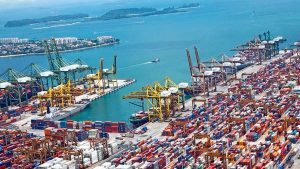As the world continues to evolve, so too does the landscape of global trade. With technological advancements, shifting geopolitical dynamics, and growing environmental concerns, the future of global trade agreements is poised for significant transformation. This article delves into the key trends and factors shaping the future of trade agreements, highlighting the roles of digital trade, sustainability, regionalism, and multilateralism.
Digital Trade: The New Frontier

One of the most prominent trends in global trade is the rise of digital trade. The proliferation of e-commerce, digital services, and data flows has fundamentally altered the way businesses operate across borders. Traditional trade agreements, which primarily focused on the exchange of goods, are increasingly incorporating provisions for digital trade.
For instance, the United States-Mexico-Canada Agreement (USMCA) includes a chapter on digital trade that addresses issues such as data localization, cross-border data flows, and cybersecurity. Similarly, the Comprehensive and Progressive Agreement for Trans-Pacific Partnership (CPTPP) has provisions that promote digital trade and e-commerce.
The future of global trade agreements will likely see a greater emphasis on harmonizing regulations related to digital trade. This includes standardizing data protection laws, ensuring the free flow of data across borders, and addressing issues related to digital taxation. As digital trade continues to grow, countries will need to collaborate to create a cohesive framework that supports innovation while protecting consumers and businesses.
Sustainability: A Growing Imperative
Another critical factor shaping the future of global trade agreements is the increasing emphasis on sustainability. Climate change, environmental degradation, and social inequality are pressing global challenges that require collective action. As a result, trade agreements are beginning to incorporate provisions that promote sustainable development.
The European Union (EU) has been a leader in this regard, integrating sustainability chapters into its trade agreements. These chapters often include commitments to uphold environmental standards, promote labor rights, and support the implementation of international agreements such as the Paris Agreement on climate change.
Future trade agreements are expected to build on this trend by including more robust sustainability provisions. This could involve commitments to reduce carbon emissions, promote renewable energy, and ensure that trade practices do not harm the environment. Additionally, there may be a greater focus on promoting fair trade practices that support social and economic development in developing countries.
Regionalism: The Rise of Regional Trade Blocs
While multilateral trade agreements have traditionally been the cornerstone of global trade, there is a growing trend towards regionalism. Regional trade agreements (RTAs) offer countries the opportunity to deepen economic integration with their neighbors and create more tailored trade policies.
The Regional Comprehensive Economic Partnership (RCEP), which includes 15 Asia-Pacific countries, is a prime example of this trend. RCEP aims to create a comprehensive and mutually beneficial economic partnership that enhances trade and investment in the region. Similarly, the African Continental Free Trade Area (AfCFTA) seeks to create a single market for goods and services across the African continent.
The future of global trade agreements is likely to see an increase in regional trade blocs, as countries seek to leverage geographic proximity and shared economic interests. These regional agreements can serve as building blocks for broader multilateral agreements, fostering greater economic cooperation and integration.
Multilateralism: Navigating Complex Geopolitics

Despite the rise of regionalism, multilateralism remains a crucial aspect of global trade. The World Trade Organization (WTO) continues to play a central role in facilitating international trade and resolving disputes. However, the WTO faces challenges, including disagreements among member countries and the need for reform to address contemporary trade issues.
The future of global trade agreements will require a delicate balance between regionalism and multilateralism. While regional trade blocs can drive economic integration, multilateral agreements are essential for creating a level playing field and ensuring that trade benefits are widely shared. Reforms to the WTO, such as updating its rules to address digital trade and sustainability, will be necessary to maintain its relevance and effectiveness.
Geopolitical Dynamics: A Shifting Landscape
Geopolitical dynamics are another critical factor influencing the future of global trade agreements. The rise of China as a global economic powerhouse, tensions between the United States and China, and the impact of Brexit are reshaping the global trade landscape.
China’s Belt and Road Initiative (BRI) exemplifies its growing influence in global trade. By investing in infrastructure projects across Asia, Europe, and Africa, China aims to enhance trade connectivity and economic cooperation. At the same time, trade tensions between the United States and China have led to the imposition of tariffs and a reevaluation of trade policies.
Brexit has also introduced new complexities to global trade, as the United Kingdom seeks to establish its own trade agreements outside of the EU. The UK’s ability to navigate these challenges and secure favorable trade deals will have significant implications for its economic future.
As geopolitical dynamics continue to evolve, countries will need to adapt their trade strategies to navigate this complex landscape. This may involve diversifying trade partners, investing in strategic industries, and leveraging diplomatic channels to resolve trade disputes.
Conclusion: Charting a Course for the Future
The future of global trade agreements is being shaped by a multitude of factors, including digital trade, sustainability, regionalism, multilateralism, and geopolitical dynamics. As countries navigate this new era, they will need to strike a balance between fostering economic growth and addressing pressing global challenges.
Trade agreements that incorporate provisions for digital trade and sustainability will be essential for promoting innovation and protecting the environment. Regional trade blocs can drive economic integration, while multilateral agreements remain crucial for ensuring a level playing field. Navigating complex geopolitical dynamics will require strategic diplomacy and adaptability.
Ultimately, the future of global trade agreements will depend on the ability of countries to collaborate and create a cohesive framework that supports inclusive and sustainable economic development. By embracing these emerging trends and addressing the challenges ahead, the global community can chart a course towards a more prosperous and equitable future.












